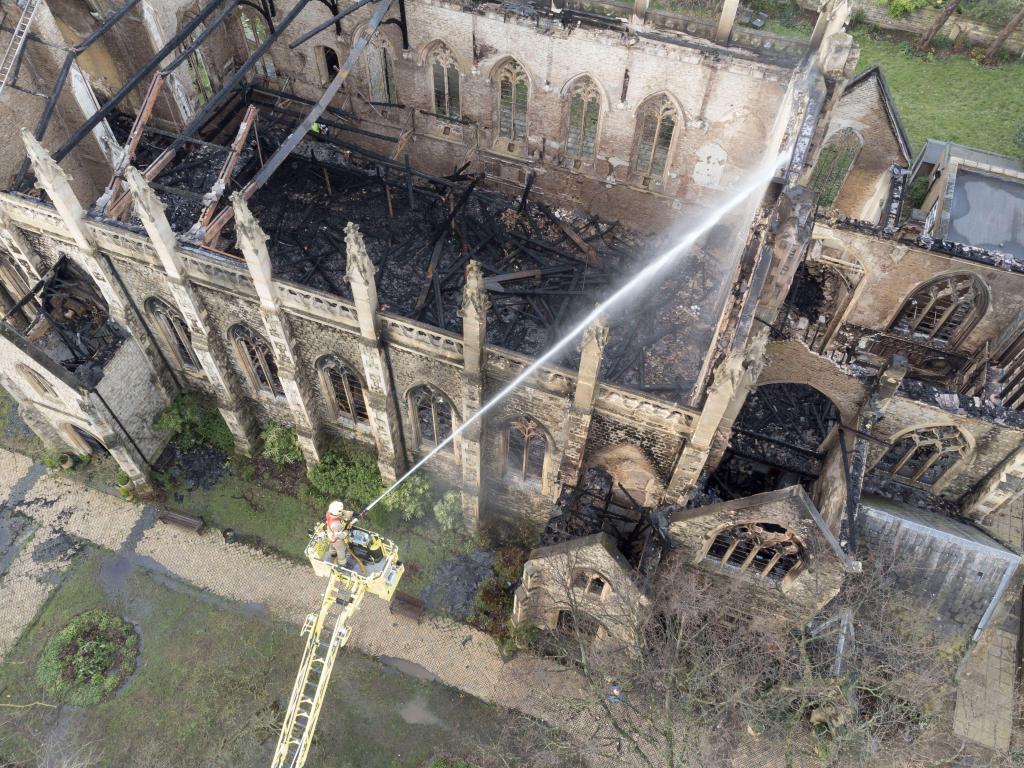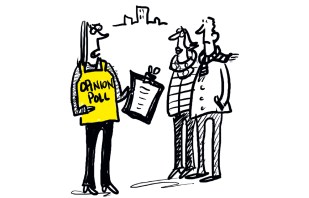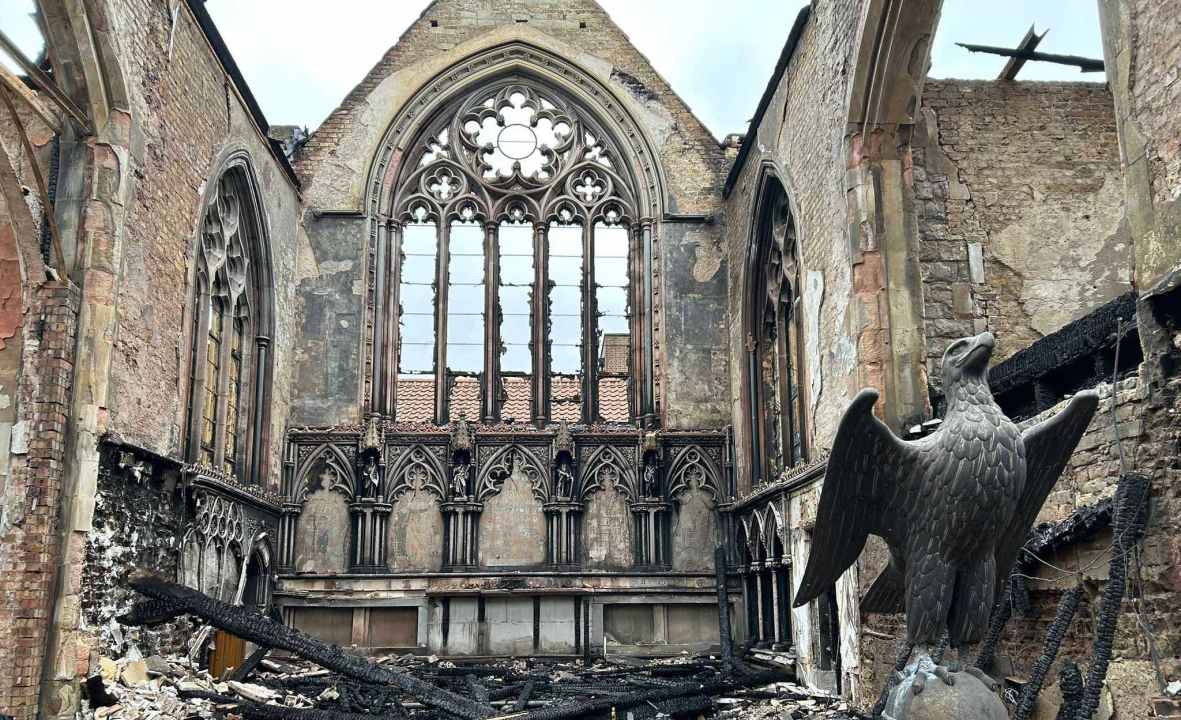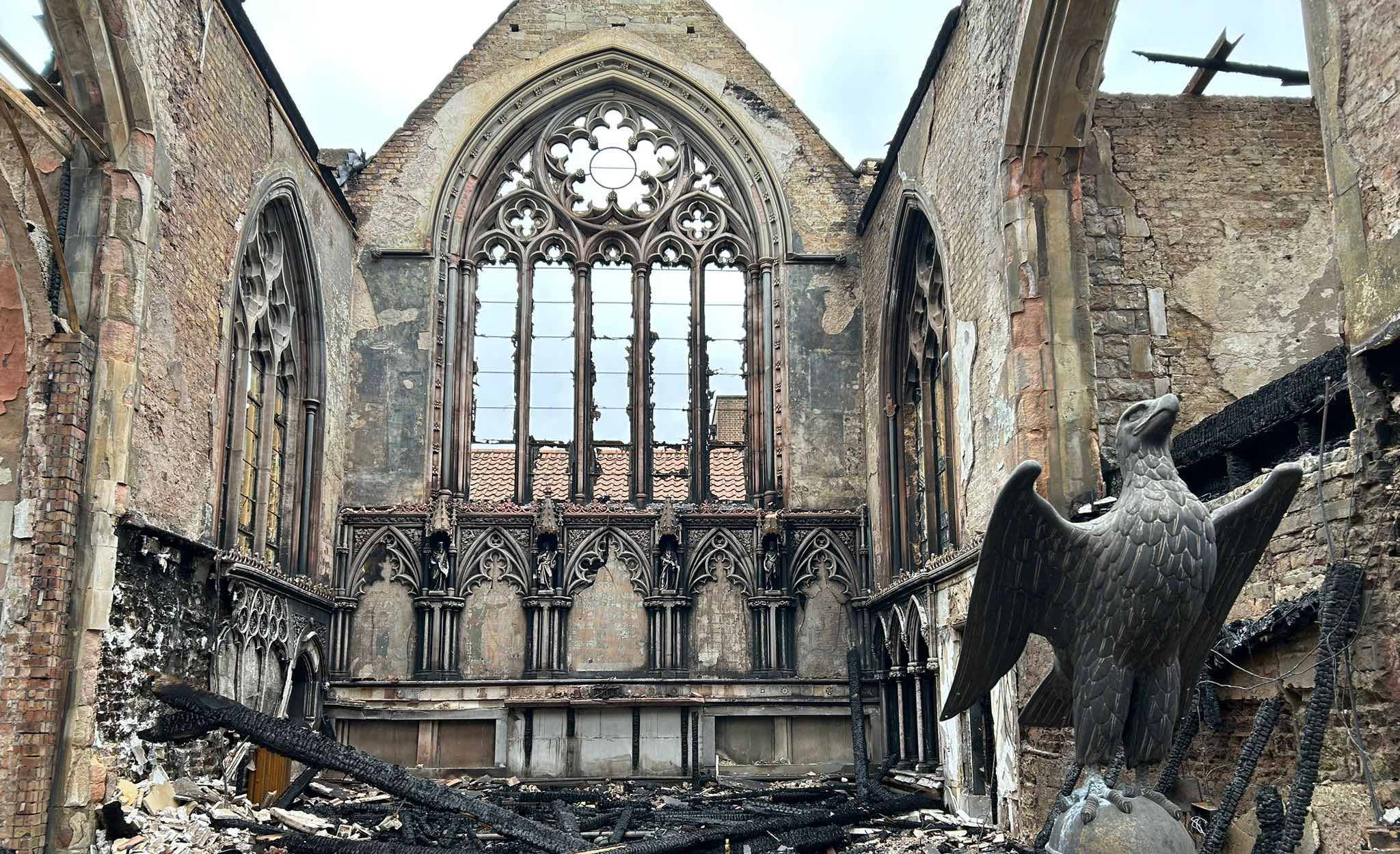As I sat down on the folding chair at Sunday morning Parish Mass, it sank a little into the mud. We were in a tent with one side open, floored with bruised and quaggy grass, like an agricultural show on a chill bank holiday.
There were 13 of us and nine in the choir, who sang a brief setting by Monteverdi. The celebrant, the Revd Kate Harrison, in alb and stole, sat behind the wooden altar on a tall office chair. A server produced clouds of incense with a thurible. A homemade board hanging from the tent-poles gave the hymn numbers: 430, 234, 408, 440. A blackbird joined in after Communion.
We were in the fresh spring air because the church of St Mark, in St John’s Wood, had burnt down on 26 January, leaving nothing but empty windows, a shell of walls and a charred steeple.
The chalice was in the locked safe in the shell that could not be entered, the hymn books had turned to gases
When Mrs Harrison – Mother Kate to her Anglo-Catholic flock – looked out of the window next morning, having gone to bed at 3 a.m. in a room provided by a neighbour, it was the spire she saw. ‘Still pointing to heaven, it meant hope,’ she recalls. ‘Then through the empty doorway, I saw the font amid the charred bits of timber, and the eagle lectern standing there. It was a kind of defiance.’
Some suggested the congregation might join a nearby church, but from the first Mother Kate was decided: they would begin again here. The pews were ashes, the chalice was in the locked safe in the shell that could not be entered, the hymn books had turned to gases. (St Andrew’s, Clewer, by the Thames at Windsor, lent a stock of the familiar green-bound New English Hymnal.)
There was, I found, a surprising beauty in the ruins, as the light fell from the open sky where the roof used to be. But the church is quite a loss. It was a big Victorian place, built to seat 1,000. Inside, before the fire, the wide nave was lit by Gothic traceried windows on each side over galleries, now fallen.
The altar under a big east window stood in an ornate chancel, with a great organ, the third largest in London. Mosaics ran along the walls and decorated the pulpit. One mosaic, of St Leonard, commemorated the Revd Joseph Hobling, taken prisoner at Dunkirk and active as a chaplain at Colditz. He was killed in an American air raid in 1944 while ministering to fellow prisoners at Stalag XVIII-A.
‘Some might think me a philistine for not regretting the organ or the mosaics, which are irreplaceable,’ Mother Kate says as we sit in the kitchen of the surviving vicarage, accompanied by an occasional housekeeping bark from Teddy the miniature schnauzer. ‘I used to sit for hours in that church. I would take my laptop there and work and talk to the people who dropped in.
‘But what we offer to the community is “being church”. It’s not even bums on pews, but souls in the kingdom.’

St Mark’s, Hamilton Terrace, halfway between Lord’s cricket ground and the music studios at Abbey Road, was built in the 1840s to designs by Thomas Cundy the younger, also responsible for a clutch of churches in Pimlico, each with a stone tower and spire punctuating the London skyline.
A bomb blew off the spire of St Mark’s in the second world war, but it was rebuilt. After the fire, a handwritten letter from a local eight-year-old ‘left us all quite teary’, says Mother Kate. It said: ‘I am really sad the church has burnt down. I used to have my birthday parties there. The building was beautiful but it’s the people who count. If you survived a bomb during the second world war, you can survive now. Stay strong!’
From the first Mother Kate was decided: they would begin again here
The first Sunday after the fire, a Candlemas service in the garden (‘Bring your own candle’) attracted 300. The Bishop of London, the Rt Revd Dame Sarah Mullally, came, not presiding but taking a place among the congregation. ‘It was very moving,’ Mother Kate remembers. ‘I thanked God for waterproof mascara.’
But keeping going is different. If you mention St Mark’s location, people often say how well-heeled the neighbourhood is. It is true that the huge studio round the corner built by Lawrence Alma-Tadema, the rather absurd Victorian painter of scenes from life in the classical world, was on the market a few years ago for £17 million. But the people I met at Mass were from very mixed backgrounds.
An old black lady edged her walking-frame round a muddy hollow to join the service. Eric, with a T-shirt, a walking stick and a mug of tea, greeted fellow worshippers with: ‘Better times will come.’ Jim, the parish treasurer, is careful and articulate. Dan, the director of music, has been singing with the prestigious Sixteen since 2008. As we trampled mud into a bare room after Mass for tea and simnel cake baked by Angela, the parish administrator, the random company seemed like survivors on a life raft.
In the middle, Mother Kate has always wanted the church to be inclusive. She emphasises the scope of Church of England parishes, which makes the incumbent responsible for everyone living in the territory ‘whether they know it or not’.
She started a thing called Messy Church once a month. Open to anyone – children, old people, the divorced – it lets them examine biblical themes, make craftwork and sit at tables to share a meal. I had no more than heard of the thing, which originated with the Bible Reading Fellowship, an inter-denominational outfit founded in 1959. Messy Church is not a club and it is not intended as a means of getting people to go to conventional church services.

At the end of the outdoor Parish Mass, Mother Kate mentioned Messy Church and said it must not be allowed to fail for lack of volunteers. I felt a bit uncomfortable.
Kate Harrison is unusual. She wears a sparkly nose stud and bright lipstick. She likes comedy nights and quiz nights. She is good at talking. She links her priesthood to a conviction that struck her at the Anglican shrine of Our Lady of Walsingham in Norfolk, which she calls ‘a difficult place for an Anglo-Catholic woman’. A proportion of Anglo-Catholics believe that women cannot validly be ordained as priests, nor, therefore, celebrate Mass or ordain others.
At Walsingham she saw the image of Mary the Mother of Jesus ‘sitting, taking up space, in order to present Christ to the world’. That, to her, is what it means to be a female priest.
The obstacles she faces now are not just ridiculous annoyances like the photocopier company ringing about hire payments for a machine burnt to a cinder. She found recently that faintness and joint pains are not merely the symptoms of long Covid, but evidence of a connective tissue syndrome. (That is why in the muddy tent she sat.)
She has felt God very present in these weeks. She had shouted at him too. Now she looks forward to the Vigil on the eve of Easter, when new fire is kindled and the Easter candle lit. She points out of the kitchen window to the vicarage garden: ‘Our fire will be here, in the middle of the grass.’







Comments